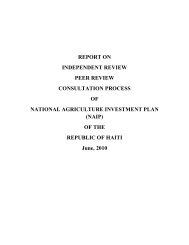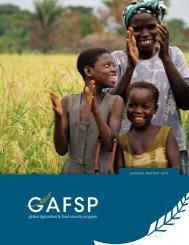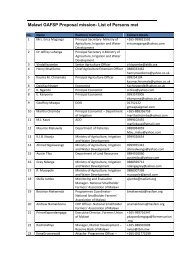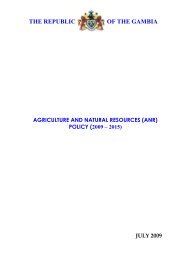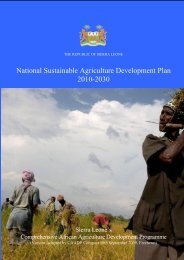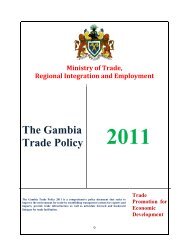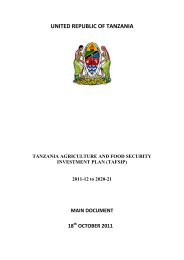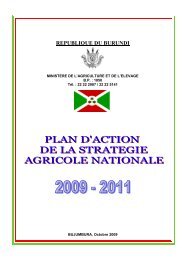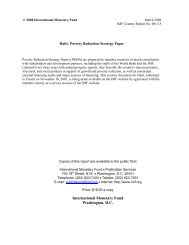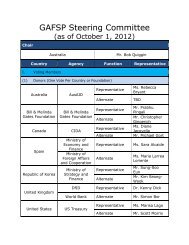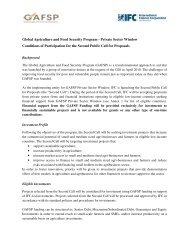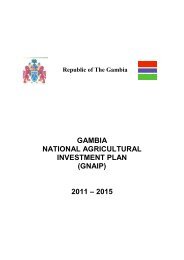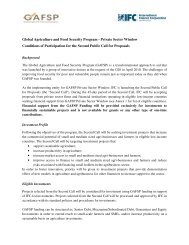World Bank Project Appraisal Document - GAFSP
World Bank Project Appraisal Document - GAFSP
World Bank Project Appraisal Document - GAFSP
Create successful ePaper yourself
Turn your PDF publications into a flip-book with our unique Google optimized e-Paper software.
19. A rigorous approach to beneficiary selection has been designed based on a combination of direct<br />
screening and the setting of an appropriate wage rate (self-targeting), to ensure that beneficiaries are<br />
drawn from among the food-insecure. Prospective beneficiaries will be screened first using the<br />
following readily observable household characteristics, which are closely associated with poverty and<br />
food insecurity: female headed households, livestock ownership, employment status, household<br />
dependency ratios, and access to remittances. All adult members of households that meet at least two<br />
of the following six criteria will be eligible for participation: female-headed households; at least one<br />
member formally registered as unemployed; no cattle; no family members abroad or remittance<br />
income; three or more children under five years old; and seven or more people in the household.<br />
Differing levels of vulnerability, as required for <strong>GAFSP</strong> reporting, will be assessed on the basis of<br />
these criteria, using the following classification:<br />
Food-insecure – two selection criteria<br />
Severe Food Insecurity – four or more selection criteria<br />
20. These criteria will be publicized and explained at jamoat and village level during awareness and<br />
communication programs prior to the start of the public works. Jamoat level records on household<br />
characteristics will be used as the basis for screening households, with the screening done jointly by<br />
jamoat and community leaders, local representatives of the Agency for Employment, Social Protection<br />
and Migration and the local NGOs employed to supervise and monitor the public works programs. As<br />
a further check on the accuracy of this screening procedure, the local NGOs will also interview a 5%<br />
sample of those on the beneficiary lists.<br />
Public Works Payments to Beneficiaries<br />
21. Following direct screening, prospective beneficiaries will be offered employment at a wage rate<br />
at the lower end of the current wage rate for unskilled rural labor. This approach, used widely in public<br />
works projects, discourages participation by higher income people while offering an adequate reward<br />
to lower income people, and minimizes labor displacement and distortion of local labor markets. The<br />
social assessment implemented during project preparation reported that rural wage rates for unskilled<br />
labor range from 20-30 TJS/day up to 40-60 TJS/day. Government has recently announced that the<br />
official minimum wage will be set at 200 TJS/month (before taxes) later this year, equivalent to<br />
approximately 10 TJS/day.<br />
22. On the basis of information on rural wages from the social assessment, the experience gained in<br />
the original project and discussions with the Agency for Employment, Social Protection and<br />
Migration, public works beneficiaries will be paid on a piece-work basis, at the rate of 17.50 TJS/m3<br />
of earth excavated before taxes and 15 TJS/m3 after taxes8. Experience with the original project<br />
shows that people excavated 1.8-2.0 m3/day, which is equivalent to a wage of 32-35 TJS/day before<br />
tax and 27-30 TJS/day after tax, which is at the lower end of the wage rate for unskilled rural labor.<br />
This piece-work rate is also slightly lower than that used in the original project of 20.00 TJS/m3,<br />
which resulted in a disproportionate level of participation by higher income people, but is well above<br />
the proposed new minimum wage. Experience from the original project also shows that this wage level<br />
is unlikely to displace rural labor.<br />
8<br />
Employer social security taxes of 25% are paid directly by the project. Beneficiaries will pay a further 1% social security<br />
tax and a 13% income tax, which will be deducted from their payments at source.<br />
25



